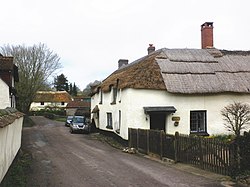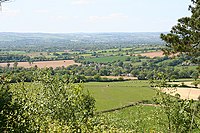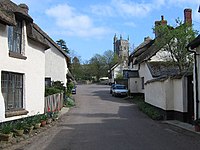Broadhembury
| Broadhembury | |
| Devon | |
|---|---|
 Ivy Cottage, Broadhembury | |
| Location | |
| Grid reference: | ST101047 |
| Location: | 50°50’8"N, 3°16’39"W |
| Data | |
| Population: | 654 (2001) |
| Post town: | Honiton |
| Postcode: | EX14 |
| Local Government | |
| Council: | East Devon |
Broadhembury is a village in the east of Devon, about five miles north-west of Honiton and within the Blackdown Hills Area of Outstanding Natural Beauty.
The village is set in the centre of a horseshoe of hills, of Hembury Fort and North Hill, which rise to 1,000 feet and create a sheltered valley.
The 2001 census recorded a village population of 654.
Parish church
The parish church is St Andrew's, which was consecrated in 1259. Most of the 13th century church was swept away in a comprehensive rebuilding in the late 15th century.[1]
One of the most impressive features inside the church is the 15th century roof, with vividly painted timbers. The painting was hidden for centuries under plaster and accidentally exposed diring repairs in 1930. The bosses at the east end retain some traces of paint.
History


Above the village on a hilltop lie the earthworks of Hembury Fort, an Iron Age hill fort accompanied by a Neolithic causewayed enclosure dating from about 3,000 BC. The fort was reused by the Romans.
The village itself is of Anglo-Saxon origin. After the Norman Conquest, the Domesday Book of 1086 records the manor as Hanberie, and states that in the time of King Edward it was owned by Brictric son of Algar, but in 1086 by Ludo and by Bishop Odo, the new King's half-brother.
In the Middle Ages, the estate belonged to Dunkeswell Abbey, six miles away.[1] Records show that during the Black Death of 1364, two priests village priests died of the plague: the toll on the ordinary villagers is not recorded.
After the dissolution of the monasteries, King Henry VIII presented the land at Broadhembury to his faithful courtier, Thomas Wriothesley, Earl of Southampton, who sold it Sir Thomas Drewe, son of Edward Drewe. Edward Drewe was responsible for the building of the manor house adjoining a small farm house at The Grange in about 1603. Edward was a sergeant at arms to Queen Elizabeth I.
Broadhembury has changed very little in outward appearance during the last century, with many of the thatch and cob cottages standing since the 16th century.
Julius Drewe purchased the inn, and half the village, at the turn of the 20th century. Broadhembury House, the large thatched residence on the north side of the church, was converted by him from an old cottage. The garden, which is of particular beauty,
The descendants of Julius Drewe of Castle Drogo, Drewsteignton, still live in the village in Broadhembury House. It is thanks to Sir Cedric Drewe, who was a Member of Parliament for many years, that the village has kept its excellent character over the years.
Outside links
| ("Wikimedia Commons" has material about Broadhembury) |
References
- ↑ 1.0 1.1 St Andrew's Church, Broadhembury on Britain Express
